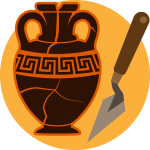"Rodents of the Cretaceous"
Some paleontologists study dinosaur fossils, but Mike prefers the remains of early mammals. One of Mike's favorite fossils from the Gobi is the skull of a small shrew-like creature called a multituberculate (mull-tee-TOOB-ur-kyoo-lit). The skull bone is as thin as a sheet of paper. Nicknamed "multis," these animals lived 80 million years ago, and probably gnawed on food like rodents do today. They were about the length of a teaspoon. Mike uses special scanning techniques to examine the tiny holes and crevices in the skull where there were once nerves and blood vessels. This information helps him understand how mammals have changed over time.
Hometown: Evanston, Illinois
Position: Senior Vice President and Provost of the American Museum of Natural History
Education: Ph.D., University of CA, Berkeley
Known for: research on fossil mammals, co-leading the Gobi expeditions
Publications: Dinosaurs of the Flaming Cliffs


And Now for Something Completely Different...
As one of the Gobi expedition leaders, Mike has had to deal with many unexpected events. In 1998, Mike experienced an odd, beautiful, and scary site. Mike recalls, "While we were driving, we saw a huge black cloud sparked with lightning. We then saw a cloud that looked like a tornado. The team drove like mad to beat the storm, but the storm had other ideas. We saw a sheet of white rushing downhill toward us. It was a flash flood! The cars started to slip in the sand. Everyone got out and walked until their feet were purple from the chilly water. Later that night, we drove down the hill, ate a delicious dinner, and slept under the stars. Phew!"
When Mike Novacek first came to the American Museum of Natural History, he studied how bats hear.
Fact
Mike was exploring how bats' and other mammals' hearing evolved based upon where they lived and what they ate.
Ukhaa Tolgod, my favorite Gobi locality, is a gold mine for finding fossils of mammals from the Cretaceous Period.

Mike Novacek
paleontologist




 Biodiversity
Biodiversity
 Brain
Brain
 Genetics
Genetics
 Marine BiOLogy
Marine BiOLogy
 MicrobiOLogy
MicrobiOLogy
 PaleontOLogy
PaleontOLogy
 ZoOLogy
ZoOLogy
 AnthropOLogy
AnthropOLogy
 ArchaeOLogy
ArchaeOLogy
 Astronomy
Astronomy
 Climate Change
Climate Change
 Earth
Earth
 Physics
Physics
 Water
Water
